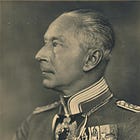Attrition at Verdun (Part IV)
The German Army of World War I
In Falkenhayn’s conception, the role of the German infantry was subsidiary to that of the artillery. It would maintain contact with the French, forcing them to bunch up into suitable targets for the artillery. It would protect artillery forward observers. And it would, by threatening to occupy the citadel of Verdun, entice the French to send as many men as possible into the meat grinder. However, whether or not the German infantry succeeded in taking that citadel, Falkenhayn emphasized on a number of occasions, was secondary to the attrition of the French forces.
Unfortunately, the commanding general of the Fifth Army did not share this vision. Crown Prince Wilhelm, the eldest son of Kaiser Wilhelm II and thus the heir apparent to the both thrones of the German Empire and that of the Kingdom of Prussia, wanted to capture the fortress of Verdun. This, he believed, was much more important than the infliction of heavy losses upon French formations.
Wilhelm’s confidence in the Fifth Army’s ability to take the fortress complex of Verdun was a direct result of recent experience. In the course of 1915, Wilhelm had acted as the protector and “chief booster” of two experimental units that were solving many of the tactical problems of trench warfare. Assault Battalion “Rohr,” the first “storm– troop” unit had developed a tactical style that used closely coordinated heavy weapons - machine guns, trench mortars, grenade launchers, and field artillery - to support the deep penetration of ten to twenty man “assault squads” armed primarily with hand grenades. The Guard Reserve Pioneer Battalion, composed largely of reservists who had been firemen in civilian life, was experimenting with a number of primitive flame throwers.
The Crown Prince’s close connection with these two units and his first hand knowledge of their achievements gave him a perspective on trench warfare that differed greatly from Falkenhayn’s. Whereas Falkenhayn was apt to see position warfare as a condition that made decisive infantry action impossible, the Crown Prince had seen the difference that the techniques developed by the then experimental assault and flame–thrower battalions could make. In a number of operations in the Vosges Mountains in the late summer and fall of 1915, German infantry trained and led by detachments from one or both of these units had repeatedly succeeded in wresting trench systems from the elite French chasseurs alpins. Wilhelm’s view of the way to run the offensive at Verdun seems to have been shared by his infantry commanders.
For Further Reading:





